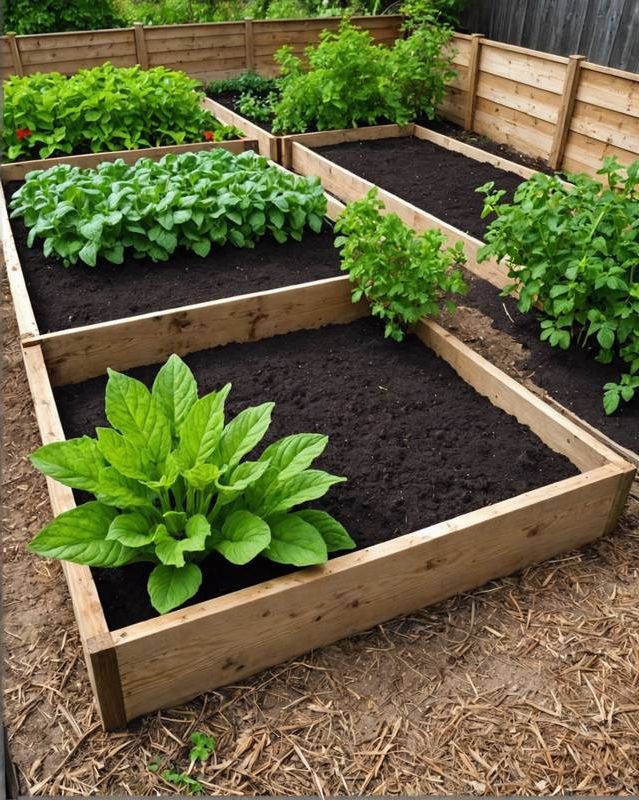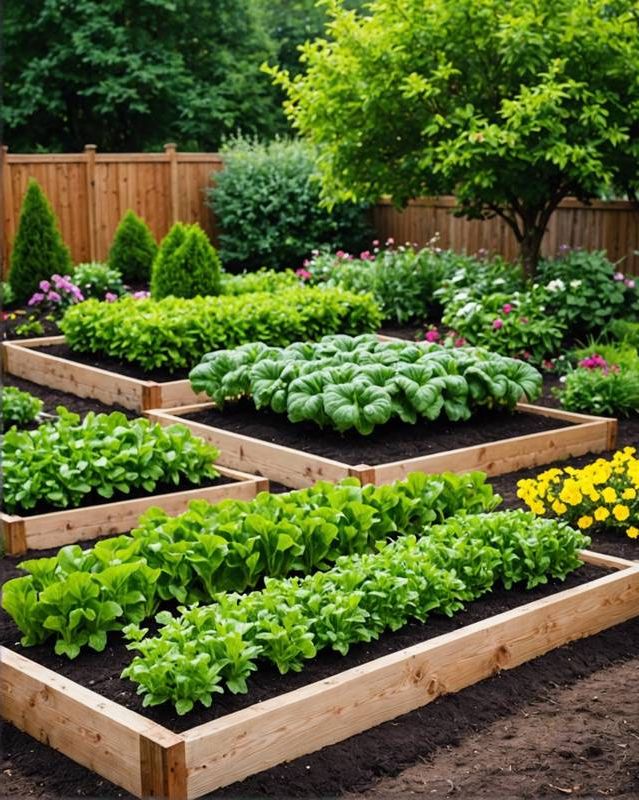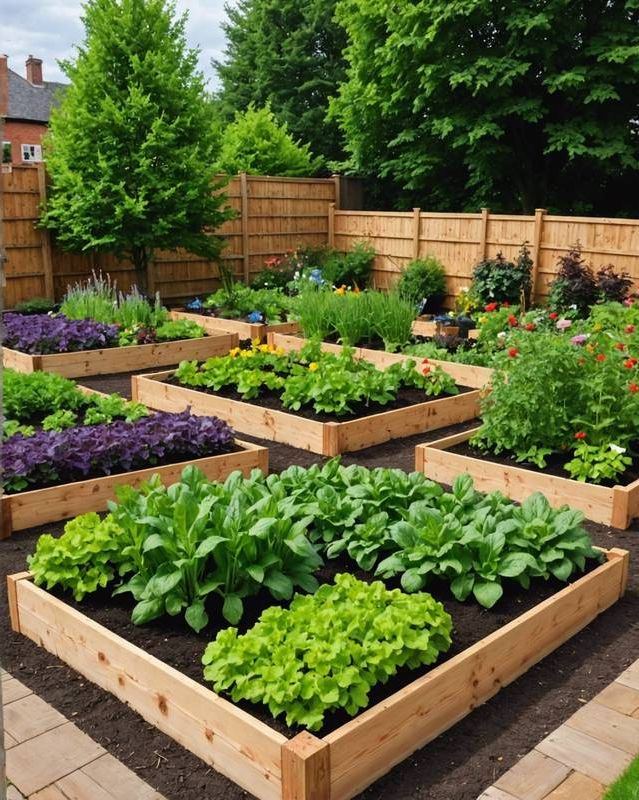Oh, hey there fellow gardener! So, I’ve been around the block a few times when it comes to gardening, and I’ve seen a lot of beginners make some mistakes with their raised beds. Whether it’s going too tall with their beds or not prepping the soil properly, there are definitely some common pitfalls to watch out for. Let’s chat about 15 of those mistakes so you can avoid them in your own garden!
Embark on this journey with me, and together, we’ll ensure your raised bed gardening adventure flourishes with bountiful harvests.
Building raised beds too high

Building raised beds too high can lead to several issues.
First, it makes it difficult for plants to access the water and nutrients in the soil, leading to stunted growth and poor yields.
Also, when you have really tall raised beds, like, they can get a bit wobbly, especially when it’s windy out. This can lead to soil getting washed away and your plants getting messed up. Just something to keep in mind!
Overly tall beds can also hinder access for tending to plants, such as weeding or harvesting.
Aim for a raised bed height of 12-18 inches, allowing for optimal plant growth and ease of maintenance.
Not amending raised bed soil

Amending the soil in raised beds is crucial for optimal plant growth.
However, many beginners overlook this essential step, leading to stunted growth and poor yields.
When you’re prepping your raised bed, don’t forget to mix in some good ol’ compost or manure to give those plants a boost of nutrients and help the soil drain better and breathe easier. It’ll make a world of difference for your garden!
Skipping soil amendment can result in compacted and nutrient-deficient soil, making it difficult for plants to establish strong root systems and absorb the necessary nutrients.
Over time, this could make your plants sad and not grow as well, which might mean you don’t get as many yummy veggies from your raised garden bed. Just something to keep in mind!
Therefore, it’s essential to take the time to properly amend raised bed soil before planting to ensure optimal growing conditions and a thriving garden.
Overwatering

So, a mistake that a lot of people make when they’re just starting out with plants is giving them too much water. It’s totally normal though, so don’t feel bad if you’ve done it before!
It’s really important to make sure your raised bed stays nice and moist, but be careful not to overdo it with the watering. Too much water can actually drown the roots and make it hard for your plants to grow properly. Plus, it can make them more vulnerable to getting sick.
Make sure you water your plants regularly, especially when it’s cooler out, and be careful not to overwater them!
If you’re unsure if your bed needs water, feel the soil an inch or two below the surface.
If it’s dry to the touch, it’s time to water.
Not providing enough drainage

Raised beds need drainage holes to prevent waterlogging, which can lead to root rot and disease. Without proper drainage, the soil becomes saturated, suffocating plant roots.
Signs of poor drainage include wilting leaves, yellowing foliage, and stunted growth.
Remember to drill or cut drainage holes in the bottom of your raised bed and place it on a slightly elevated surface to promote water runoff.
Planting too densely

Crowding plants in raised beds can be a pitfall for beginners. When plants are packed too tightly, they compete for sunlight, water, and nutrients.
This can lead to stunted growth, reduced yields, and susceptibility to pests and diseases.
To avoid these issues, give your plants ample space to develop and thrive. Plant according to the recommended spacing for each species and consider thinning out seedlings as needed.
By providing enough space, you’ll maximize the health and productivity of your raised bed garden.
Not fertilizing

Overfertilizing raised beds can lead to a host of problems, including nutrient burn, reduced growth, and even death of plants. While it’s important to provide your plants with essential nutrients, it’s equally important to avoid overfeeding them.
If you’re not sure how much fertilizer to use, it’s always best to start with a low dose and increase it gradually as needed.
When picking a fertilizer, make sure it’s the right fit for your plants. You don’t want to overload them with too much nitrogen, as that can result in sparse flowers or fruits and spindly, feeble plants.
Not protecting from pests

Dealing with pests in your raised bed garden can be a real pain. They love to munch on your plants, make them sick, and just cause all sorts of trouble for you. It’s super frustrating, right?
If you don’t take steps to protect your plants from pests, you’re likely to end up with a disappointing harvest.
There are a number of things you can do to protect your raised bed plants from pests. Using row covers is a great way to keep insects away from your plants.
You can also use companion planting to deter pests.
Certain plants, such as marigolds and nasturtiums, can help to repel pests. Additionally, you should regularly inspect your plants for pests and remove any that you find.
Not rotating crops

Crop rotation is an essential gardening practice that helps maintain soil health, prevent disease, and maximize yields.
Hey there! Just a friendly heads up – if you stick to planting the same crops in the same spot without mixing it up, you might run into issues like sucking the nutrients out of the soil, getting hit with more diseases, and even drawing in more pests. Just thought you should know!
For instance, if you plant tomatoes in the same bed year after year, the soil can become depleted of nitrogen and potassium, making the plants more susceptible to diseases like blight and blossom end rot.
Oh, and another thing to watch out for are those pesky pests that love munching on tomatoes, like hornworms and aphids. If you keep planting tomatoes in the same spot over and over again, these little guys can really start to multiply in the soil. Just something to keep in mind!
By rotating crops, you distribute these issues over different parts of the garden, reducing their impact on any one bed.
Not mulching

Mistake #11: Not Mulching Mulching provides a multitude of benefits for your raised bed, including moisture retention, weed suppression, temperature regulation, and improved soil health.
By skipping mulching, you lose out on these advantages and risk compromising the growth and overall well-being of your plants.
Using unhealthy plants

One thing we see a lot with newbies is they end up choosing plants that aren’t in the best shape. It’s totally normal, we’ve all been there! Just make sure to keep an eye out for those healthy, robust plants next time.
When you start with weak or diseased plants, you’re setting yourself up for failure.
Diseased plants are more susceptible to pests and diseases, and they will not produce as much food.
If you do end up with unhealthy plants, it’s best to remove them from your garden as soon as possible.
This will really help stop any sickness from spreading to your other plants.
Not hardening off plants

Hardening off plants is a crucial step before transplanting them outdoors. By gradually exposing them to outdoor conditions, you help them adapt to the real world and reduce transplant shock.
Skipping this process can lead to wilting, yellowing, and even death.
So, take your time and give your plants the love they need to thrive in their new home.
Not paying attention to weather conditions

Weather is a key factor in gardening success. Not paying attention to weather conditions can lead to a number of problems, including: Overwatering or underwatering plants Plants being damaged by wind or hail Plants being scorched by the sun Plants being killed by frost It is important to be aware of the weather conditions in your area and to adjust your watering and care accordingly.
For example, if you know that a storm is coming, you should water your plants deeply so that they have enough water to last through the storm.
You should also protect your plants from wind and hail by covering them with a tarp or moving them to a sheltered area.
Not planning ahead

Lack of planning can derail your raised bed gardening adventure. Without a clear plan, you may end up with haphazard bed placement, inadequate soil preparation, or a chaotic mix of plants that compete for resources.
Take the time to plan the location, size, and orientation of your beds.
Think about how much sunlight your plants like and try to keep them together in the same spot. Oh, and don’t forget to really get that soil ready by mixing in some compost or manure to give them the best chance at growing well.
A well-planned raised bed will set the stage for a thriving and productive garden.
Getting discouraged

It can be easy to become discouraged if your vegetables aren’t growing as you hoped. Don’t give up! Gardening is a learning process.
Take some time to troubleshoot the problem.
Determine if your plants are getting enough sunlight, water, and nutrients. Make sure the soil is well-drained.
Once you’ve identified the issue, you can take steps to correct it and get your plants back on track.
Not having fun

If you’re finding raised bed gardening more like a chore than a joy, it’s time to rethink your approach.
Gardening should be an enjoyable hobby, not a source of stress.
Consider if you’re biting off more than you can chew.
Start with a smaller garden size to reduce workload and make it more manageable.
It’s also crucial to choose plants that thrive in your climate and soil conditions.
By doing this, you’ll have less work to do in the garden and you can enjoy it without any stress.







